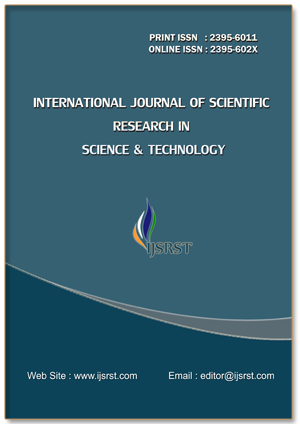Morphological and Compositional Study of Nitrogen-TiO₂ Anchored Composite with Azo Dyes in a DSSC
DOI:
https://doi.org/10.32628/IJSRST24115117Keywords:
Dye-Sensitized Solar Cells, Nitrogen-TiO2, Azo dyes, SEM analysis, EDSAbstract
The efficiency of Dye-Sensitized Solar Cells (DSSCs) heavily relies on the structural and morphological characteristics of the photoanode materials [1]. This study investigates the effects of Nitrogen on TiO2 and the subsequent anchoring with two different Azo dyes RP and VC, to evaluate their impact on DSSC performance [2]. A comprehensive analysis was conducted using Scanning Electron Microscopy (SEM) to study the surface morphology of pure TiO2, Nitrogen TiO2 (N-TiO2), and N-TiO2 composites with RP and VC Azo dyes [3]. Energy-Dispersive X-Ray Spectroscopy (EDS) provided insight into the elemental composition and confirmed the successful incorporation of nitrogen into the TiO2 structure. The SEM images reveal significant morphological differences between the pure and N-TiO2 samples, as well as changes induced by the azo dye anchoring [4]. The Nitrogen incorporation was found to increase surface roughness and enhance dye adsorption [5]. A comparative analysis of the N-TiO2 composite with RP and VC azo dyes highlights variations in dye distribution and surface coverage, which may influence light absorption and charge transfer efficiency. The findings provide valuable insights into the design of optimized photoanode materials, aiming to improve the photovoltaic performance of DSSCs [6].
Downloads
References
O'Regan, B., & Grätzel, M. (1991). A low-cost, high-efficiency solar cell based on dye-sensitized colloidal TiO2 films. Nature, 353(6346), 737-740. DOI: https://doi.org/10.1038/353737a0
Chen, X., & Mao, S. S. (2007). Titanium dioxide nanomaterials: synthesis, properties, modifications, and applications. Chemical Reviews, 107(7), 2891-2959. DOI: https://doi.org/10.1021/cr0500535
Zhang, Q., Cao, G. (2011). Nanostructured photoelectrodes for dye-sensitized solar cells. Nano Today, 6(1), 91-109. DOI: https://doi.org/10.1016/j.nantod.2010.12.007
Hagfeldt, A., Boschloo, G., Sun, L., Kloo, L., & Pettersson, H. (2010). Dye-Sensitized Solar Cells. Chemical Reviews, 110(11), 6595-6663. DOI: https://doi.org/10.1021/cr900356p
Hao, S., Wu, J., Huang, Y., & Lin, J. (2006). Natural dyes as photosensitizers for dye-sensitized solar cell. Solar Energy, 80(2), 209-214. DOI: https://doi.org/10.1016/j.solener.2005.05.009
Grätzel, M. (2003). Dye-sensitized solar cells. Journal of Photochemistry and Photobiology C: Photochemistry Reviews, 4(2), 145-153. DOI: https://doi.org/10.1016/S1389-5567(03)00026-1
Grätzel, M. (2009). Recent advances in sensitized mesoscopic solar cells. Accounts of Chemical Research, 42(11), 1788-1798. DOI: https://doi.org/10.1021/ar900141y
Peter, L. M. (2011). Dye-sensitized nanocrystalline solar cells. Physical Chemistry Chemical Physics, 13(28), 13140-13161.
Di Valentin, C., Pacchioni, G., & Selloni, A. (2004). Origin of the photoactivity of nitrogen-doped titanium dioxide. Journal of Physical Chemistry B, 108(21), 7330-7338.
Kay, A., & Grätzel, M. (1993). Low cost photovoltaic modules based on dye sensitized nanocrystalline titanium dioxide and carbon powder. Solar Energy Materials and Solar Cells, 44(1), 99-117. DOI: https://doi.org/10.1016/0927-0248(96)00063-3
Kavan, L., Grätzel, M., Rathouský, J., & Zukal, A. (1996). Nanocrystalline TiO2 (anatase) electrodes: Surface morphology, adsorption, and electrochemical properties. Journal of Electrochemical Society, 143(2), 394-400. DOI: https://doi.org/10.1149/1.1836455
Downloads
Published
Issue
Section
License
Copyright (c) 2024 International Journal of Scientific Research in Science and Technology

This work is licensed under a Creative Commons Attribution 4.0 International License.
https://creativecommons.org/licenses/by/4.0





